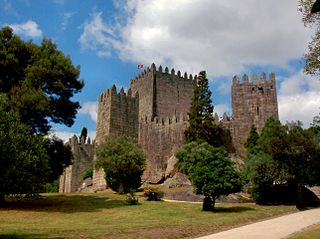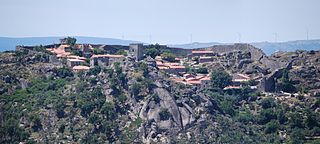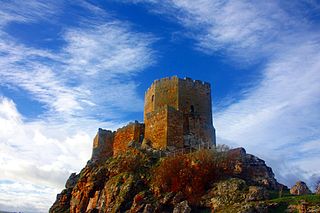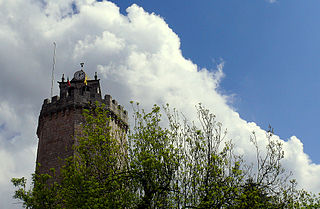
The Castle of Guimarães, is the principal medieval castle in the municipality Guimarães, in the northern region of Portugal. It was built under the orders of Mumadona Dias in the 10th century to defend the monastery from attacks by Moors and Norsemen.

Diogo de Arruda was a noted Portuguese architect that was active during the early years of the 16th century. He had some other important family members including his brother, Francisco de Arruda and his uncle, Miguel de Arruda.

The Castle of Santa Maria da Feira is a Portuguese castle in the municipality of Santa Maria da Feira, district of Aveiro. Emblematic of Portuguese medieval military architecture, the Castle of Santa Maria da Feira is one of the monuments that best reflects the diversity of defenses used during the Middle Ages, having been instrumental in the process of Reconquista and autonomy of the County of Portugal. It has been listed as a National monument since 1910.

The Castle of Belver is a Portuguese castle in the civil parish of Belver, municipality of Gavião, district of Portalegre, in central Portugal.

The Castle of Terena is a castle in the civil parish of Terena in the municipality of Alandroal in the Portuguese subregion of Alentejo Central. Since 1946, it has been listed as a National monument.

The Castle of Alandroal is a medieval castle in the civil parish of Alandroal, São Brás dos Matos e Juromenha, municipality of Alandroal, Portuguese district of Évora, classified as a National Monument.

The Castle of Faria is a castle in the northern Portuguese civil parish of Gilmonde, municipality of Barcelos, in the Cávado.

The Castle of Sortelha (Portuguese: Castelo de Sortelha is a castle in the civil parish of Sortelha in the municipality of Sabugal in the Portuguese Centro region, classified as a National Monument.

The Castle of Alenquer, is a Portuguese medieval castle in civil parish of Alenquer, in the municipality of Alenquer, in the district of Lisbon.

The Castle of Pombal is a medieval castle in the civil parish of Pombal, municipality of the same name in the district of Leiria in the Centre region of Portugal.

The Castle of Vidigueira is a castle in the civil parish of Vidigueira in the municipality of Vidigueira in the Portuguese subregion of Baixo Alentejo. Although constructed in the first half of the 15th century, it is more commonly associated with the first of the Counts of Vidigueira: Vasco da Gama.

The Castle of Algoso is a medieval castle in the civil parish of Algoso, Campo de Víboras e Uva, municipality of Vimioso, in the Portuguese district of Bragança. The castle of Algoso is one of the most important medieval fortifications in the eastern Trás-os-montes, related with the battles of Leonese succession, the tentative policies of the independent Portuguese monarch and the important religious commandery of the Knights Hospitaller that established their roots in 1224.
The Castle of Montalvão is a medieval castle in the civil parish of Montalvão, municipality of Nisa, in the Portuguese district of Portalegre.

The Castle of Pena de Aguiar is a medieval castle, alternately the Castle of Aguiar da Pena, situated in the civil parish of Telões, in the municipality of Vila Pouca de Aguiar, in the Portuguese district of Vila Real.

The Castle of Freixo de Espada à Cinta is located in the civil parish of Freixo de Espada à Cinta e Mazouco, municipality of Freixo de Espada à Cinta, in the Portuguese district of Bragança.

The Castle of Castelo Melhor is a medieval castle located in the civil parish of Castelo Melhor, in the municipality of Vila Nova de Foz Côa, Portuguese Guarda. The castle is one of the best examples of secondary medieval fortresses, erected in one of the more peripheral zones of the peninsular kingdoms.

The Castle of Lanhoso is a medieval castle located in civil parish of Póvoa de Lanhoso, municipality of Póvoa de Lanhoso, Portuguese district of Braga of Portugal.

The Castle of Redondos is a medieval castle located in the civil parish of Buarcos, in the municipality of Figueira da Foz, Portuguese Coimbra.

The Castle of Ródão is a medieval castle located in the civil parish of Vila Velha de Ródão, in the municipality of Vila Velha de Ródão, Portuguese Castelo Branco.
























